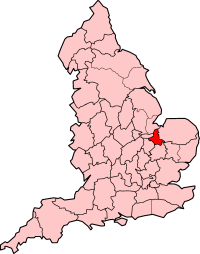Isle of Ely County Council
| Isle of Ely | |
|---|---|
 |
|
| Area | |
| • 1891 | 239,259 acres (968.2 km2) |
| • 1961 | 239,951 acres (971.0 km2) |
| • Coordinates | 52°24′N 0°15.5′E / 52.400°N 0.2583°ECoordinates: 52°24′N 0°15.5′E / 52.400°N 0.2583°E |
| Population | |
| • 1891 | 63,861 |
| • 1961 | 89,180 |
| History | |
| • Origin | Liberty of Ely |
| • Created | 1889 |
| • Abolished | 1965 |
| • Succeeded by | Cambridgeshire and Isle of Ely |
| Status |
Administrative county (within Cambridgeshire) |
| Government | Isle of Ely County Council |
| • HQ | County Hall, March |
 |
|
The Isle of Ely /ˈiːli/ is a historic region around the city of Ely in Cambridgeshire, England. It used to be a county in its own right.
Its name is said to mean "island of eels", a reference to the creatures that were often caught in the local rivers for food. This etymology was first recorded by the Venerable Bede.
Until the 17th century, the area was an island surrounded by a large area of fenland, a type of swamp. It was coveted as an area difficult to penetrate, and was controlled in the very early medieval period by the Gyrwas, an Anglo-Saxon tribe. Upon their marriage in 652, Tondbert, a prince of the Gyrwas, presented Æthelthryth (who became St. Æthelthryth), the daughter of King Anna of the East Angles, with the Isle of Ely. She afterwards founded a monastery at Ely, which was destroyed by Viking raiders in 870, but was rebuilt and became a famous Abbey and Shrine. The Fens were ultimately drained. This began in 1626 using a network of canals designed by Dutch experts. Many Fenlanders were opposed to the draining as it deprived some of them of their traditional livelihood; acts of vandalism on dykes, ditches and sluices were common, but the drainage was completed by the end of the century.
The area's natural defences led to it playing a role in the military history of England. Following the Norman Conquest, the Isle became a refuge for English forces under Earl Morcar, Bishop Aethelwine of Durham and Hereward the Wake in 1071. The area was taken by William the Conqueror only after a prolonged struggle. In 1139 civil war broke out between the forces of King Stephen and the Empress Matilda. Bishop Nigel of Ely, a supporter of Matilda, unsuccessfully tried to hold the Isle. In 1143 Geoffrey de Mandeville rebelled against Stephen, and made his base in the Isle. Geoffrey was mortally wounded at Burwell in 1144.
...
Wikipedia
